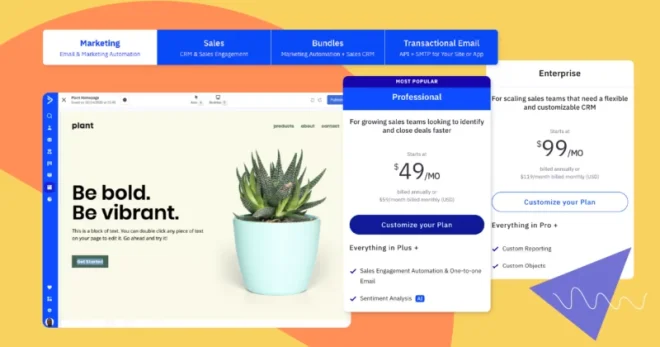Do you know that an average office worker gets 121 emails per day? And these are only work-related emails, not to mention all those marketing ones piling up in their inboxes. They come from small businesses, entertainment companies, clothes shops, cinemas, airplane companies etc. They can even add up to 200 mails per day.
It is quite obvious that such a hefty number of emails can overwhelm. Who are we kidding, most of them will probably be forgotten. And only the most interesting and outstanding ones will be read scrupulously as the rest will sink into oblivion.
Nevertheless, this overabundance of emails sent every day (worldwide it is estimated that 120 billion emails are sent per day!) doesn’t discourage business owners from email communication with their customers and email marketing. Therefore, since emails are so popular not only in digital marketing world but also among traditional businesses like clothes shops or cinemas, the competition in potential customers’ inbox is quite fierce. And only those who know how to write a good email will survive.
Keep in mind that there are various forms of emails you can send on a regular basis. In this article, I’m going to focus on 1:1 emails. When it comes to product updates emails, it’s more common to use graphics, irregular text structure, etc. Remember about your clients’ needs and try to… address them in your emails.
Keep in mind that there are various forms of emails you can send on a regular basis.
Once you read this article you will know:
- why email writing is important,
- how to write a proper email – structure and best email writing tips,
- how to write a formal email.
Make your sections smartable and let go of mundane manual tasks with Smart Sections! An easy way to manage bulk changes.
Why email writing is important
There is a general tendency to undermine the importance of email writing as “everybody can do this”, and no one truly wonders how to write effective emails. Well, more or less, it is true, but not everybody can do this in an effective or professional way. And poor email writing can lead to:
- losing good reputation among other entrepreneurs, employees or customers,
- losing trust and loyalty of customers,
- not being treated in a professional way by other companies,
- harming your own business.
As you can see, consequences of neglectful approach to email are quite severe not only in regards to your business but also speaking of customers and potential collaboration partners. It can shut many doors and significantly hinder your business development.
On the other hand, once you master email writing skills and know how to write a mail, you can avoid all the consequences mentioned as well as:
- improve business communication with customers, partners and employees,
- make good impression on clients and inspire trust,
- present yourself as a professional expert,
- boost professional confidence.
It is worth mentioning that no one is born with the skill of perfect email writing and everyone has to learn. Sometimes it happens intuitively after reading dozens of emails (what is not that difficult considering the fact you can get more than 100 per day), but sometimes it is advisable to look closer on email writing best practices and excel at this from now on.
How to write a proper email?
If you wonder how to write a good email, you need to take two aspects into consideration: the structure and the best email writing practices. The structure is crucial especially when it comes to formal emails while best email writing practices let you outstand with your mails and inspire trust or action.
Structure of a proper email
Before we move on to the rules governing high quality emails, it is essential to scrutinize the structure that every decent email should have. It consists of four basics elements such as:
- subject,
- opener,
- body,
- closing.
Subject
While there are many important factors when it comes to choosing whether to open the email or not, it is worth noting that “35% of email recipients open emails basing on the subject line alone” (according to Convince & Convert). Thus, the subject line has a huge impact on the opening rate, so it should:
- grab attention,
- be concise (the highest open rate has those with 6-10 words),
- provide the most crucial information on what an email is about.

Opener
In the vast majority of emails, a quick greeting such as semi-informal “Hello” or more formal “Dear John” will do. Choosing appropriate greetings is important, as it sets a tone to an email. The rest of the email should be written accordingly (especially when it comes to formal emails).
After a greeting, the best practice is to concisely acknowledge a given recipient what the purpose of your email is, before they dive into your main message. You can use phrases such as:
- “I’m reaching out because…”,
- “I’ve noticed that… and I believe I can help you with…”.
Body
Body of an email is the essence of your entire message and it should have a clear purpose: asking for feedback, informing about an event, offering a new product or a special discount (then you should add a Call to Action leading to your landing page or directly to your offer), or setting up a meeting with a new customer.
The body should be concise, informative, without any fluff. As Shafer said, “Nobody wants to receive a novel. You want to keep it between three, four, or five lines of text”.
“Nobody wants to receive a novel. You want to keep it between three, four, or five lines of text”.
Closing
Every email should be started with a greeting and ended with a nice, friendly sign-off. You can use phrases such as:
- “I look forward to hearing from you. Kind regards…”,
- “Let me know if you need anything. Best wishes…”,
- “Keep me posted. Many thanks…”.
There are loads of possibilities when it comes to closing emails, and you should choose the ones most suitable for your email purpose, recipients and the tone you have already adopted in an email.
Remember to sign the email with your name, position and the company name so that your recipient knows who they’re dealing with. Also, think about whether to sign the email only with your position held, or to also emphasize on the fact that you write on the behalf of the whole team.
How to write a formal email?
A formal email is a message you send to a person you don’t know well or to a person who’s in a position of authority. They can be a public official, a professor, a business owner you collaborate with. In formal emails the defined email structure presented before is absolutely necessary and you should not use abbreviations, jargon, emoticons or contractions (in an informal email, you can).
A subject line in formal emails should have as many details as possible and it should give a recipient a notion of what an email is about. Nevertheless, it should not be too long (up to 10 words) and you should remember to keep it informative.
When it comes to openers and closings, you should use those formal ones only. You can start with “Dear Mr/Mrs/Miss…” and finish your mail with a polite “Yours sincerely…” or “Yours faithfully”. Do not start with “Hi..” or “Hello…” or end with “See ya soon” as these are reserved for informal messages.
Last but not least, the body should be concise and meaningful. Try to clearly explain the purpose of your email using appropriate language and keep in mind who you turn to. If a person might be unfamiliar with the topic you bring up, or if you refer to the topic that has drowned for some time, do explain in a sentence or two what it is all about in order to avoid misunderstanding.
When it comes to openers and closings, you should use those formal ones only. You can start with “Dear Mr/Mrs/Miss…” and finish your mail with a polite “Yours sincerely…” or “Yours faithfully”.
As you can see, everybody can easily learn how to write a proper email and do this in an effective way. The most important aspect of decent emails is to remember to include all the necessary elements as well as an appropriate subject line, which has a huge impact on whether emails are read or not. You should also have in mind all the email writing tips mentioned.
Once you follow email writing rules, you are able to take your email creation to a new level and significantly improve your business communication with customers, partners or employees. Or just keep Dan Munz’s message in mind: “How to write a good email: 1. Write your email 2. Delete most of it 3. Send”.
Boost your email campaigns!








